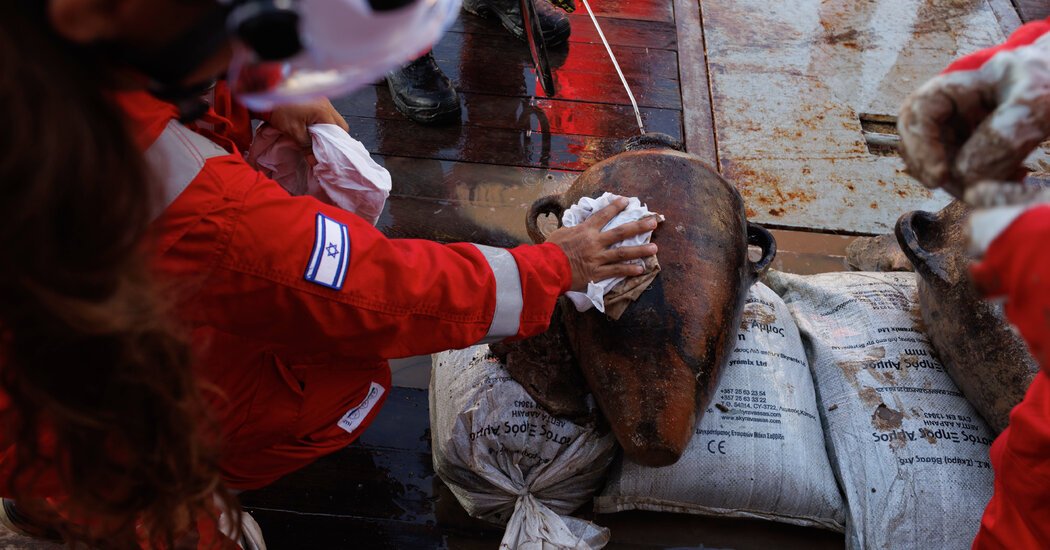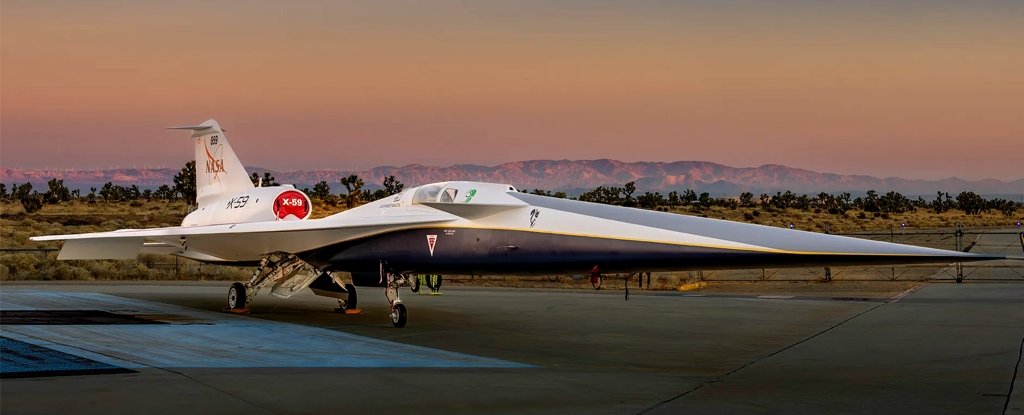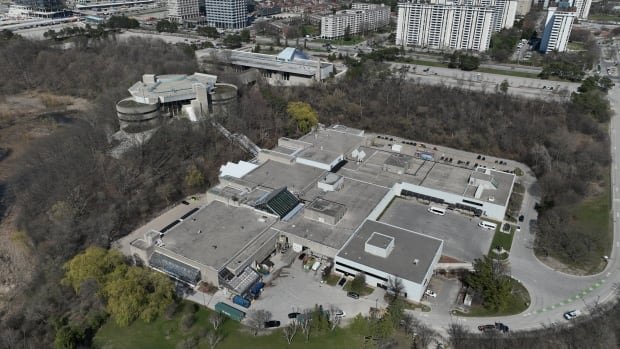Remains of the oldest shipwreck ever discovered in deep water, and perhaps the oldest complete wreck in any water, have been located in the Mediterranean Sea about 56 miles off the coast of northern Israel.
The Israel Antiquities Authority, which announced the find on Thursday, said that preliminary examination of two clay jars known as Canaanite amphorae indicated that the merchant vessel, an estimated 39 to 46 feet long, sank sometime between 1400 B.C. and 1300 B.C., an epoch when the Egyptian empire stretched from what is now northern Syria to Sudan, and the boy pharaoh Tutankhamun briefly sat on the throne.
Whether the galley was the victim of a sudden storm, a wayward wind or attempted piracy is unclear. But judging from footage recorded by a remotely operated submersible robot, the craft settled to the bottom without capsizing, and the hundreds of storage jars in its hold survived pretty much intact.
Cemal Pulak, a nautical archaeologist at Texas A&M University who was not involved in the find, said, “I consider any Bronze Age shipwreck discovery to be a very important one as shipwrecks of this period are extremely rare.” They are so rare that only two other wrecks with cargo are known from the late Bronze Age in the Mediterranean — both found, unlike the current one, off the Turkish coast relatively close to the shore and accessible using standard diving gear. The more recent of those two discoveries occurred in 1982. No spectacular new finds have surfaced since then.

The new Bronze Age wonder was detected last summer at a depth of about a mile during a survey conducted by Energean, a London-based company seeking to develop natural gas fields. The patch of seafloor had been claimed by both Israel and Lebanon until a 2022 agreement brokered by the United States put it under Israeli control.
Energean’s remotely operated vehicle, or R.O.V., was tethered to a surface vessel by a steel cable and controlled by a pilot on the ship working a joystick much like the ones used to play video games. At roughly 3,300 feet below the surface — about 2,000 feet above the sunken ship’s location — even the faintest light has faded, leaving a sunless realm known as the aphotic zone. Cameras on the robotic R.O.V. are fitted with powerful lights that pierce the perpetual darkness.
Last July, the R.O.V. filmed what appeared to be a large pile of jugs on the seafloor. The images were sent to the antiquities agency, which identified the jugs as late Bronze Age storage jars designed to hold, among other things, honey, olive oil and resin from the Pistacia atlantica tree. Such resin was used as a preservative in wine and, in Egypt, as incense and as varnish on funerary equipment of the New Kingdom era.
Having piqued the interest of the Antiquities Authority, Energean had two mechanical appendages built for the R.O.V. that were capable of extracting artifacts from the pile with minimal risk of damage to the entire assemblage. Over two days at sea this May, the vehicle mapped the site and determined that the amphorae rested in a vessel half-embedded in sediment. There was no sign of an anchor, a mast or the square sail typically used by Mediterranean trade ships of the time.
“The ship is preserved at such a great depth that time has frozen since the moment of disaster,” said Jacob Sharvit, the director of maritime archaeology for the Israel Antiquities Authority and the leader of the May reconnaissance expedition. “Its body and contents have not been disturbed by human hands nor affected by waves and currents that impact shipwrecks in shallower waters.”
Extending its robotic arms, the R.O.V. removed two jars from the hull, one from each end of the ship. Both turned out to be filled with silt. “An analysis of the jar’s trace elements should solve the question of what was inside when the vessel went under,” Dr. Sharvit said.
The 14th century B.C. in the eastern Mediterranean was a dynamic period of international trade and enormous wealth concentrated in the hands of a few. Scattered along the coast of the Levant were the great Canaanite commercial centers, which dispensed strategic and utilitarian raw materials and manufactured goods to the Aegean region and beyond. Chief exports were copper and tin, which, when mixed, would make bronze to manufacture stronger farming tools that increased agricultural yield and produce arms and armor to equip entire armies.
Much of what is known about the nature of late Bronze Age trade is based on two shipwrecks excavated in southern Turkey — the first at Cape Gelidonya in 1960, and the second at Uluburun from 1984 to 1994. Using these finds, scholars assumed that commerce in the late Bronze Age was accomplished by safely flitting from port to port, hugging the coastline within eye contact of shore.
A Turkish sponge diver in 1982 first reported spotting “metal biscuits with ears” off a rocky promontory known as Uluburun. Scientists speculated that the ship he had spotted was sailing from the Levant to Greece when it foundered around 1300 B.C. According to Dr. Pulak, director of the Uluburun expedition, the vessel carried 10 tons of copper and one ton of tin, along with other commodities and exotic materials including a gold scarab inscribed with the name of Nefertiti, glass ingots, ivory, ebony, hippos’ teeth, ostrich eggs, tools fashioned out of goods from at least 11 Asian, African and European cultures, and about 150 Canaanite amphorae, of which roughly 120 contained resin.
The ship found earlier at Cape Gelidonya went down about 1200 B.C. It also carried copper and tin, but in more meager quantities, as well as scrap bronze in the form of farming implements intended for recycling.
“Those two shipwrecks exemplify different modes of trade,” Dr. Pulak said. “The Uluburun ship represented long-distance interregional elite exchange, and the Cape Gelidonya ship was involved in local coastal cabotage, or opportunistic trade, where goods and services were purchased and sold at ports for quick profit.”
The newly found wreck suggests Bronze Age traders traveled much farther from ports.
“The discovery of this boat now changes our entire understanding of ancient mariner navigational skills,” Dr. Sharvit said. “It is the very first to be found at such a great distance with no line of sight to any landmass. From this geographical point, only the horizon is visible all around.”
Dr. Sharvit speculated that, lacking compasses, astrolabes or sextants, seafarers in the 14th century B.C. probably relied on celestial navigation, taking sightings and angles of the sun and star positions. He said the wreck promised to advance scientific knowledge of late Bronze Age trade patterns and the peoples who controlled them.
“The two previous Bronze Age shipwrecks marked trading routes between Cyprus, the Levant and places in the eastern Aegean Sea,” Dr. Sharvit said. “Our wreck suggests a seagoing exchange was conducted west out of Syria and Canaan to southern Cyprus, Crete and other Greek lands.”
Alternatively, he proposed, the doomed sailors on the deep-sea galley might have sailed from an Aegean port, debarked with cargo in a Levantine harbor and loaded the ship with the Canaanite amphorae for the return voyage. Dr. Sharvit said that if that were the case, the seamen might have been Mycenaean, a civilization that by 1400 B.C. had overrun Crete and most of southern Greece and had a virtual monopoly on commerce in the eastern Mediterranean.
Dr. Pulak called the three Bronze Age shipwrecks invaluable time capsules. But while the Uluburun wreck was excavated over the course of 22,413 dives, Dr. Sharvit said the Israeli authorities planned to preserve the deep sea site as is, without bringing up more of the wreck for the moment.
“We think that is the best way to keep the shipwreck safe right now,” he said. “We want to save it for the next generation, with better technology and methodology to excavate at that depth.”










